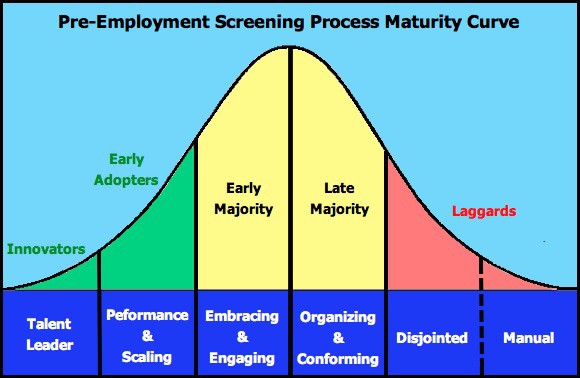How to Assess Your Small Business’s Pre-Employment Screening Maturity
A turnkey, effective pre-employment screening process is critical for today’s small business. We rely on pre-employment screening efforts to alert us of red flags with a candidate, verify the accuracy of one’s employment records, ensure the safety of existing employees, and explore whether one may thrive despite the demands of a position. And don’t forget the importance of saving time for busy HR Directors by reducing the chance of expensive turnover later.
There is a wide spectrum onto which companies may fall when it comes to pre-employment screening process maturity. Identify your small business’s place on this Bell curve as a first step toward improving your new hire screening, background checking, and reference checking methods.
Your Pre-Employment Screening Process Maturity Level
It’s time to get real. How do your company’s resources impact your placement on the maturity curve? Into which category does your company fall on the image below?

Manual
Companies lagging behind in this phase are resistant to technology in most areas of talent management. They are focused on manual activities such as using hard copy paper employment applications, collecting printed resumes at job fairs, and promoting the ability to apply in person (despite the absence of an on-site kiosk for electronic submission of applications). Businesses in this bucket may not even be doing background checks or reference checks on candidates who have received a conditional offer of employment. If the company has started to grow more quickly recently, putting these methods in place can be further delayed if nepotism is present and new hires frequently come from existing employee referrals. Additionally, it is unlikely that the standard employment application offers the opportunity to incorporate well-planned screening questions that flesh out whether candidates meet at least the basic qualifications for a position. Lastly, you can assume that any web presence on behalf of human resources is completely managed by the IT department.
Disjointed
Companies in this bucket are often plagued by a lack of staff bandwidth (often an HR department of one trying to support too many employees) and poor buy-in from upper management. They launch isolated efforts to supplement the pre-employment screening process, but do not execute a universal, organization-wide strategy. For example, they utilize employee assessments for only some positions; use inconsistent techniques for reference checking and/or fail to train all hiring managers to follow the same protocol; inconsistently use social media to screen applicants (potentially a big liability); job-specific screening questions are underutilized and ultimately depend on the attentiveness of the hiring manager involved; and there is no automated way to group job candidates based on whether they satisfied basic qualifications. Additionally, these companies may still be collecting background check-related information (such as previous residences and Social Security number) on the employment application (without a compelling industry-related reason) because it is easier for them…neglecting the fact that it can disengage applicants and raise a red flag when the solicitation of that information is not connected with a conditional offer of employment.
Organizing & Conforming
Companies in this stage have the right structure in place for optimizing the pre-employment screening process – including an applicant tracking system and a means to collect employment references and electronic employment applications from applicants. While the integration of technology has advanced these companies into the “late majority” part of the cycle, activities such as reference checking are likely still handled inconsistently and may eat up the HR staff’s time. Though they probably have a go-to background checking vendor in place, they still may be collecting disclosures to run these checks in a cumbersome way (i.e. emailing candidates later in the process with a separate request form and then not having an automatic way for results for the check to flow back into an applicant tracking system). Upper management supports HR initiatives as it recognizes the need to put sound practices in place as the company grows, but the pace of growth is still outpacing the ability to get the right HR resources in place quickly enough. The HR department has a lot on its plate and needs to become even more efficient and strategic as pre-employment screening efforts have covered the tactical bases like background checking and reference checking, but still haven’t touched screening question development on a consistent basis.
Embracing & Engaging
For these companies, a strategic process is in place so that consistent screening techniques are used for every position in the organization and thoughtful job evaluation is used to create relevant and results-oriented job-specific screening questions. The right applicant tracking software technology is in place to allow human resource administrators the ability to quickly and easily view applicants that meet basic qualifications based on answers to questions…and those applicants that score particularly well are highlighted, accordingly. Success in hiring leads to further engagement from hiring managers to help develop job questions, respond about candidates quickly and utilize pre-employment testing tools. This partnership with hiring managers leads to opportunities to continuously re-evaluate and repeat success in the future.
Performance & Scaling
Scalability is of central concern for companies in this stage. They seek to further optimize their pre-screening efforts and are intimately attune with promoting a positive employment brand to both applicants and current employees. By regularly tracking key performance indicators such as time to hire and cost per hire, among others, HR personnel have already proven the business case for using technology to their CFO and company ownership. Many of these companies have undergone a significant spike in hiring recently, and have sought additional ways to leverage technology to avoid taking on more staff unnecessarily. Examples include bi-directional integration with background checking, behavioral and cognitive employee assessment tools and automated reference checking software in which the applicant is especially engaged to impact the responsiveness of his/her references. The HR department, whether comprised of one person or many individuals at this near-mastery level, is very agile, uses practical, easy-to-learn HR technology software and likely has enviable statistics when it comes to number of offers extended to accepted and turnover.
Talent Leader
These companies are completely passionate about attracting and hiring top talent…having employment brand ambassadors from entry-level employees all the way up to the CEO. The return on investment for pre-employment screening efforts has repeatedly been proven as well as scaled as the business expands (and expansion for small business can often mean a pretty drastic percentage increase in growth)…thanks in part to savvy reporting tools available in hiring software such as applicant tracking systems and online reference checking software. Other companies will look to this organization to mimic its hiring techniques and try to steal talent…but the latter attempt will often fail as the leading company has done a great job of pre-screening talent and engaging candidates and employees in the process. The talent leader will have little trouble fielding applicants for most job postings due to its reputation as a choice employer.
Does your business fall into your preferred category when it comes pre-employment screening maturity? What resources can help you move ahead on the pre-employment screening process maturity curve? To find out, visit our ExactHire resources section or contact us today.
Image credit: Curve of Droplets by Andreas. (contact)











 15% OFF FULL-SERVICE HIRING • APPLICANT TRACKING SOFTWARE • ONBOARDING SOFTWARE
15% OFF FULL-SERVICE HIRING • APPLICANT TRACKING SOFTWARE • ONBOARDING SOFTWARE